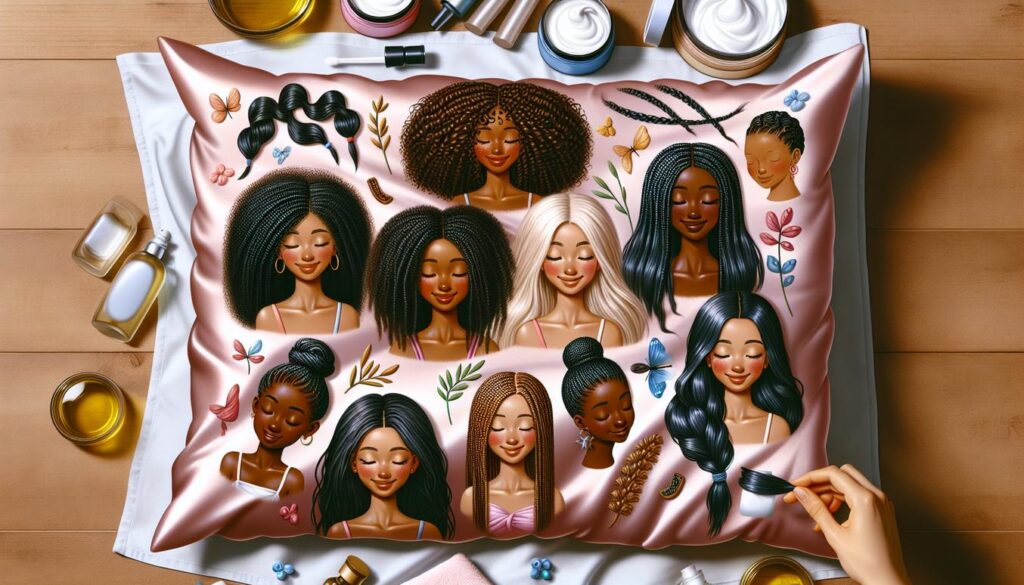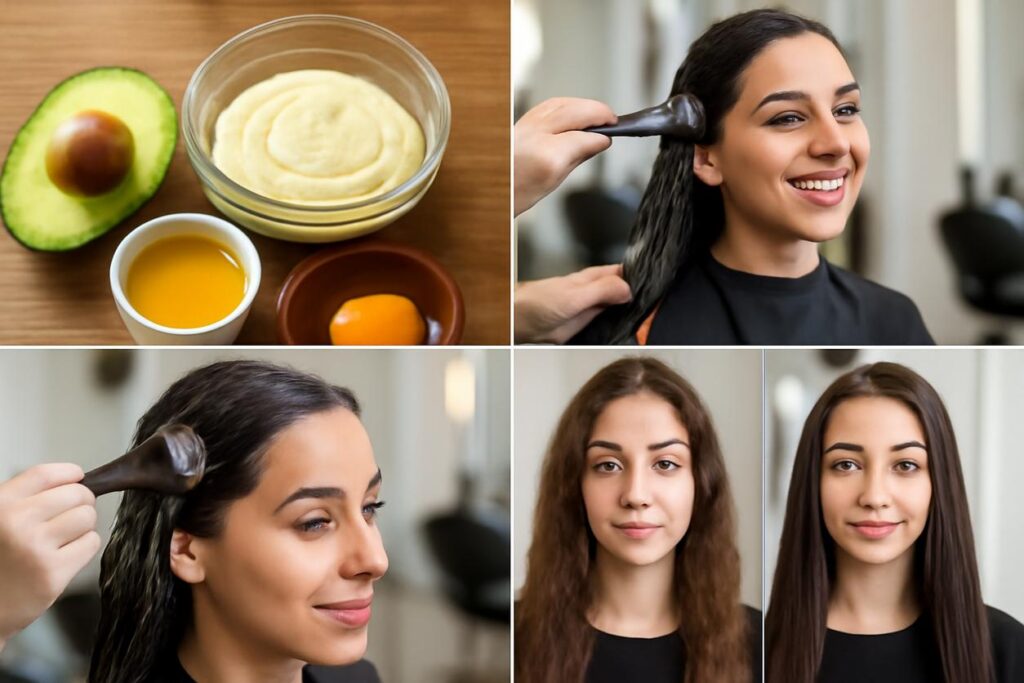Table of Contents
- Why Overnight Hair Care is Your Secret to Healthier Hair
- Quick Hair Type Check and What It Means at Night
- Core Nightly Steps for Every Hair Type
- Your 2025 Night Routine for Straight Hair (Type 1)
- Your 2025 Night Routine for Wavy Hair (Type 2)
- Your 2025 Night Routine for Curly and Coily Hair (Types 3 and 4)
- Protective Styles and Sleep-Friendly Methods
- Gentle DIY Overnight Masks and Oil Treatments
- Adjustments for Color-Treated or Thinning Hair
- Common Overnight Hair Care Mistakes to Avoid
- Morning Wake-Up Steps to Preserve Overnight Benefits
- Choosing Products by Ingredient, Not Buzzwords
- Reader Questions Answered
- Sources and Further Reading
Why Overnight Hair Care is Your Secret to Healthier Hair
You spend about a third of your life sleeping, so why not make that time work for your hair? Just as your skin repairs itself at night, your hair can also benefit immensely from a dedicated routine. Overnight hair care is the practice of protecting and treating your hair while you sleep to minimize damage and enhance its health. It’s a proactive approach that turns passive rest into an active recovery period for your strands.
The primary goal is to combat the two biggest nighttime culprits: friction and moisture loss. Tossing and turning on a standard cotton pillowcase can rough up the hair’s cuticle, leading to frizz, tangles, and breakage. At the same time, absorbent fabrics can wick away natural oils, leaving hair dry and brittle. A proper **overnight hair care** strategy shields your hair from these issues, meaning you wake up with smoother, more manageable, and healthier locks. This not only saves you time on morning styling but also contributes to long-term hair resilience.
Quick Hair Type Check and What It Means at Night
Before you can build the perfect nighttime routine, you need to understand your hair’s unique needs. Hair is generally categorized by its texture (straight, wavy, curly, coily) and its porosity (how well it absorbs and retains moisture). Knowing where you fall on this spectrum is the foundation of effective **overnight hair care**.
- Straight Hair (Type 1): Prone to oiliness at the roots and tangles at the ends. The focus is on preserving volume and preventing greasy buildup.
- Wavy Hair (Type 2): Can easily be weighed down and is susceptible to frizz. The goal is to enhance the natural wave pattern without causing flatness.
- Curly Hair (Type 3): Needs significant moisture to maintain definition and prevent frizz. The priority is hydration and protecting the curl shape.
- Coily Hair (Type 4): The most fragile type, requiring maximum moisture retention and gentle handling to prevent breakage.
Understanding your hair’s structure is key. For a comprehensive breakdown, explore our detailed hair type guide. This knowledge will help you choose the right products and techniques for a truly personalized routine.
Core Nightly Steps for Every Hair Type
Regardless of your hair type, a few fundamental practices form the backbone of any successful **overnight hair care** plan. Integrating these simple habits can make a world of difference.
Gentle Detangling
Never go to bed with tangled hair. Small knots can turn into major mats overnight. Use a wide-tooth comb or your fingers to gently detangle your hair, starting from the ends and working your way up to the roots. This prevents stress on the hair shaft and minimizes breakage.
Choosing Your Sleep Surface
Swap your cotton pillowcase for one made of silk or satin. These materials have a smoother surface, which reduces friction against your hair. Your strands will glide over the pillow instead of snagging, resulting in fewer tangles and less frizz come morning. This is one of the simplest yet most effective changes you can make.
Securing Your Hair
Leaving your hair loose can lead to tangles, especially if you move a lot in your sleep. However, securing it too tightly can cause tension and breakage. Opt for loose, sleep-friendly styles using soft hair ties like scrunchies made of silk or satin.
Your 2025 Night Routine for Straight Hair (Type 1)
For those with straight hair, the **overnight hair care** challenge is to manage oil at the scalp while protecting fragile ends, all without sacrificing volume.
Pre-Bed Prep
If your hair tends to get oily, a light spritz of dry shampoo at the roots before bed can work wonders. It will absorb excess sebum overnight, leaving your hair looking fresh in the morning. For your ends, apply a single drop of a lightweight oil, like argan or grapeseed oil, to keep them hydrated without weighing your hair down.
Styling for Sleep
A loose braid is an excellent option for straight hair. It prevents tangles and can create soft, heatless waves by morning. Alternatively, a high, loose bun secured with a scrunchie (often called a “top knot”) can help maintain volume at the roots.
Your 2025 Night Routine for Wavy Hair (Type 2)
Wavy hair sits between straight and curly, meaning it needs a balance of moisture and lightweight products to avoid being weighed down or becoming frizzy.
Pre-Bed Prep
Revive your waves by lightly misting your hair with water mixed with a small amount of leave-in conditioner. Gently scrunch to encourage your wave pattern. This rehydrates the hair and helps it form defined waves overnight.
Styling for Sleep
The “plopping” method is fantastic for wavy hair. After applying your product, you can “plop” your hair into a microfiber towel or an old cotton t-shirt for 20-30 minutes before bed to absorb excess water and enhance definition. For sleeping, gather your hair into a loose “pineapple” — a high, loose ponytail on top of your head — to protect the wave structure.
Your 2025 Night Routine for Curly and Coily Hair (Types 3 and 4)
For curly and coily hair types, **overnight hair care** is all about moisture, moisture, and more moisture. The key is to protect the delicate curl pattern and prevent dryness.
Pre-Bed Prep
Applying products in layers using a method like the LOC (Leave-in, Oil, Cream) or LCO (Leave-in, Cream, Oil) method can be transformative. This technique locks in hydration. Apply a water-based leave-in conditioner, followed by a sealing oil, and finally a rich curl cream to define and moisturize.
Styling for Sleep
The “pineapple” style is a go-to for preserving curls. For tighter coils, multiple “mini-pineapples” or two-strand twists can be more effective. The most crucial step is to wrap your hair in a silk or satin bonnet or scarf. This provides the ultimate barrier against friction and moisture-absorbing pillowcases, ensuring your curls stay defined and hydrated.
Protective Styles and Sleep-Friendly Methods
A protective style is any hairdo that tucks away the ends of your hair, protecting them from damage. These are essential components of an effective **overnight hair care** routine.
- The Loose Braid: Classic and simple. It keeps hair contained and minimizes tangles. A single braid works for straight or wavy hair, while multiple braids are great for curly and coily types.
- The Pineapple: A high, loose ponytail on the very top of your head. This protects the length of your hair and is particularly popular for preserving curl patterns.
- Bantu Knots or Twists: Ideal for curly and coily hair, these styles not only protect the hair but also help to stretch it and create beautiful, defined patterns for the next day.
- The Silk or Satin Bonnet/Scarf: This is a non-negotiable for anyone serious about **overnight hair care**, especially those with textured hair. It encases the hair, providing a 360-degree shield against friction.
Gentle DIY Overnight Masks and Oil Treatments
You don’t need expensive products to give your hair a nourishing overnight boost. Simple, natural ingredients from your kitchen can be incredibly effective. Always perform a patch test before applying a new treatment.
Simple Hydrating Aloe Vera Mask
Mix two tablespoons of pure aloe vera gel with a few drops of jojoba oil. Aloe vera is hydrating and jojoba oil closely mimics your scalp’s natural sebum. Apply lightly to your hair, focusing on the mid-lengths and ends. Cover with a shower cap or bonnet to protect your bedding.
Nourishing Coconut Oil Treatment
For very dry or damaged ends, warm a small amount of virgin coconut oil in your palms and apply it sparingly. Coconut oil is deeply moisturizing but can be heavy, so it’s best for thicker hair types and should be kept away from the scalp to avoid oiliness.
For more ideas and recipes, check out our complete guide to DIY masks and oils.
Adjustments for Color-Treated or Thinning Hair
Specific hair conditions require a more tailored **overnight hair care** approach.
For Color-Treated Hair
Color-processing can make hair more porous and prone to dryness. Focus on moisture and color-safe products. Use leave-in conditioners with ingredients like silk proteins to strengthen the hair shaft. Avoid very heavy oils overnight, which can sometimes affect certain types of hair dye. A silk pillowcase is especially important to prevent cuticle damage that can lead to color fading.
For Thinning or Fine Hair
The priority here is to avoid weighing the hair down and to promote scalp health. Avoid heavy creams and butters. Instead, opt for lightweight serums. Never tie your hair tightly, as this can cause traction alopecia. A gentle scalp massage with a few drops of diluted rosemary oil before bed can help stimulate circulation without making hair greasy.
Common Overnight Hair Care Mistakes to Avoid
What you don’t do is just as important as what you do. Steer clear of these common pitfalls:
- Going to bed with wet hair: Hair is at its most fragile when wet. Tossing and turning on wet hair is a recipe for breakage and can also encourage fungal growth on the scalp.
- Using tight hair ties: Elastic bands with metal clasps or tight ponytails create tension points, leading to breakage. Always opt for soft, loose ties like scrunchies.
- Over-applying product: More is not always better. Using too much product can lead to buildup, weigh hair down, and clog scalp pores.
- Skipping detangling: Going to sleep with knots will only lead to a tangled, unmanageable mess in the morning. A few minutes of gentle combing can save you a lot of time and frustration.
Morning Wake-Up Steps to Preserve Overnight Benefits
Your morning routine should complement your **overnight hair care** efforts, not undo them.
The Gentle Takedown
Carefully undo your braids, twists, or bun. Avoid pulling or ripping through your hair. Use your fingers to gently separate sections and fluff your hair at the roots to restore volume.
Refreshing Your Style
You likely won’t need a full restyle. For curls and waves, a light mist of water or a curl refresher spray can bring them back to life. For straight hair, a quick brush-through and a touch of serum on the ends is often all that’s needed to tame any minor flyaways.
Choosing Products by Ingredient, Not Buzzwords
Navigating the world of hair products can be confusing. For your **overnight hair care** routine, focus on ingredients that deliver tangible benefits rather than marketing claims. Here’s a quick guide for what to look for in your 2025 and beyond shopping:
| Goal | Look for These Ingredients |
|---|---|
| Moisture | Hyaluronic Acid, Glycerin, Aloe Vera, Panthenol (Vitamin B5) |
| Sealing and Frizz Control | Jojoba Oil, Argan Oil, Shea Butter, Squalane |
| Strength and Repair | Hydrolyzed Keratin, Silk Amino Acids, Peptides, Biotin |
| Scalp Health | Rosemary Oil, Tea Tree Oil, Peppermint Oil, Salicylic Acid |
Reader Questions Answered
How often should I do an overnight hair care treatment?
This depends on your hair’s needs. For most hair types, a deep conditioning mask or oil treatment once or twice a week is sufficient. However, nightly protection with a silk pillowcase and a loose hairstyle should be a daily habit.
Is sleeping with a bonnet really necessary?
While not strictly necessary for everyone, it is highly recommended, especially for those with curly, coily, or frizz-prone hair. It offers the best protection against friction and moisture loss, far more than just a silk pillowcase alone.
Can overnight hair care cause breakouts?
Yes, it can. If heavy oils and creams from your hair transfer to your pillowcase and then to your face, it can clog pores. To prevent this, ensure your hair is fully contained in a bonnet or scarf, and be sure to change your pillowcases frequently.
Sources and Further Reading
The principles of effective **overnight hair care** are grounded in dermatological science and trichology, focusing on cuticle protection, hydration, and minimizing physical stress on hair fibers. For more in-depth guides and personalized tips, explore our dedicated resources.






